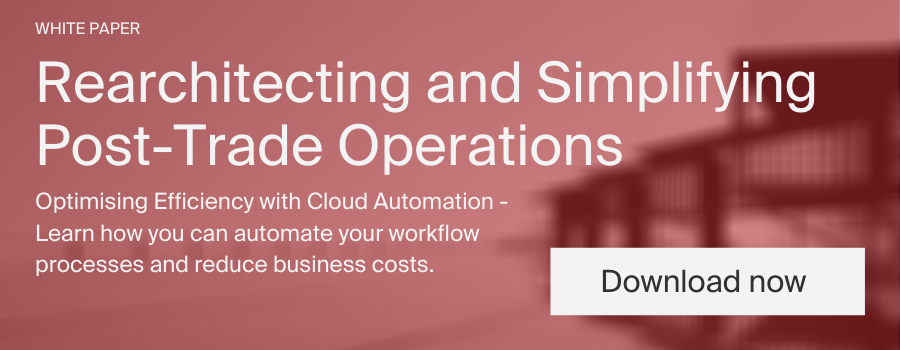
The settlement cycle evolution will demand a more flexible, modern middle office.
The US post-trade utility, DTCC, has proposed that the settlement cycle for US securities should switch to T+1 during early 2024, supported by industry bodies including the Securities Industry and Financial Markets Association (SIFMA), the Investment Company Institute (ICI).
The many stages that comprise post-trade processing will also need to be shortened without any loss in service quality. To handle the faster processing time, capital markets firms will need to manage a massive shift in their IT infrastructure.
This will be more significant for some organisations than others, depending upon the existing systems and infrastructure they already have in place. Historically, post-trade processing was conducted via batch processing either overnight or intraday. This move to a shorter cycle means, at a fundamental level, that batch processing is dead. Processing will have to become real time. It will rely upon event-driven automation to ensure that the checks and balances needed to ensure effectiveness can be completed within the T+1 timeframe.
There is an ongoing automation of manual processes from pre-trade through to middle office which happens organically to help operations focus on the exceptions management day-to-day. The imposition of an industry deadline will create a benchmark for the pace and range that this activity takes.
The importance of the middle office and risk management
To support the effective transition and ongoing success, the middle office within banks will become a more significant part of the workflow in reducing settlement failures. The middle office, as the primary function in managing risk, will become a focus for operational pressure and will therefore need to be invested in.
Within risk management, automation can reduce pressure, particularly around risk limits which need to be handled in real-time but also require monitoring. This level of functionality will identify exposures and any breaking of limits for particular counterparties or sectors.
In the longer term, the impact of T+1 will be to reduce costs, notably as the capital buffers can be held for shorter periods of time. Equally the smaller window means that exposure to market risk will be reduced.
Over the short-term, the changes needed will necessitate extra expenditure and further cost/complexity may increase through operational risk, as a result of having shorter deadlines for the same level of work adding greater pressure on the operational and technological performance in the middle and back office. If changes are not delivered effectively, whether in the processes or IT systems, there will also be a cost to operational failures.
If middle office systems are still reliant on legacy technology, lacking the capacity to handle real-time processing, and often lacking API integration with the front and back offices, it will be impossible to support the necessary level of performance. Manual intervention to re-key information between platforms will be impossible at T+1 and so there will need to be effective interfacing between front, middle and back office tools. For firms with modern middle office systems the costs will be significantly lower.
Consequently, risk and IT functions must consider how much they might need to increase their spend in order to drive down the overall costs to the business by putting the right processes in place.
Timeframes, project management and motivation
Regulators and market infrastructure providers will also be engaged in a significant process shift, with rules and market plumbing being overhauled, tested and going live ahead of the deadline.
There may be delays in the process, as is common for new industry regulations, due to the need all market participants move forward in lockstep, alongside the authorities and trade infrastructure providers. However, it would be a risk for firms to become complacent in their management of the change.
There are also other factors which might encourage investment banks to make changes ahead of regulatory deadlines. The demand for, and roll out of, digital assets within investment vehicles is already driving some of the changes needed behind the scenes to reduce handling of a shorter settlement lifecycle.
As digital assets are effectively processed with real-time settlement, investment managers and their sell-side counterparts will be under pressure to support the level of security that end investor clients expect. Client or institutional investor accounts will often use pre-funding, or full funding ahead of asset purchasing, where other securities trading is enabled via payment-vs-delivery backed by a transfer from custodian to the broker once a trade is confirmed.
Getting prepared for that will help in other ways. There are already T+1 environments in many jurisdictions around the world so firms should harmonise their global middle and back office systems, cutting run costs for the management and operation of those functions.
As banks seek to support the risk management associated with these trades, pressure on their middle office will increase. Tools will be needed to handle confirmation and exceptions using real-time risk management processing, with the demand that makes on associated data accessibility and transfer.





